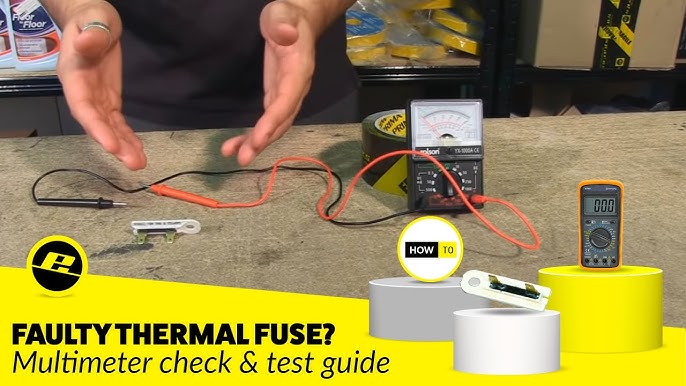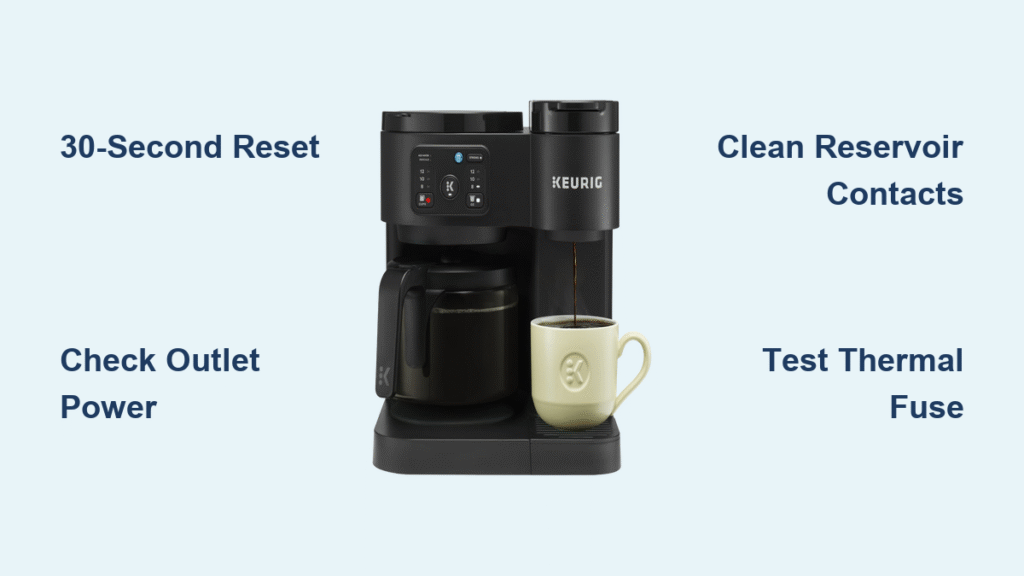You wake up craving your morning coffee only to find your Keurig completely dead—no lights, no sounds, nothing. This frustrating power failure strikes even relatively new machines without warning, leaving you staring at a silent appliance when you need caffeine most. The good news is that keurig coffee maker troubleshooting no power issues often reveals simple solutions you can implement in minutes without professional help. In this guide, you’ll discover step-by-step fixes for complete power failure, learn how to identify when a thermal fuse has blown, and understand whether your machine is worth repairing or replacing.
Before you consider buying a new coffee maker, try these proven troubleshooting techniques that resolve 80% of no-power cases. We’ll walk through everything from basic power resets to advanced component checks, helping you diagnose whether your problem stems from a simple outlet issue or requires professional service. Most importantly, you’ll learn prevention strategies to avoid this coffee emergency with your next brewer.
Immediate Fixes for Keurig Power Failure
30-Second Power Reset That Actually Works
This simple procedure solves most “no power” issues but requires precise timing—many users skip the critical waiting period. Start by unplugging your Keurig completely from the wall outlet. Never just turn it off using the power button, as residual electricity remains in the system. After disconnecting, press and hold the power button for 5 seconds while unplugged to drain any remaining charge.
Wait exactly 30 seconds—this allows internal capacitors to fully discharge. During this time, check that your water reservoir is properly seated, as misalignment can prevent power restoration. Plug your Keurig directly into a wall outlet (not a power strip), press the power button firmly, and watch for the “Add Water” light to flash blue. If you see this blue flash, your machine has power and you’ve successfully completed keurig coffee maker troubleshooting no power issue.
Pro Tip: If your Keurig came with a water pump protection feature, hold the brew button for 3 seconds after powering on to clear residual water from the system. This prevents error messages after a power restoration.
Water Reservoir Reset Technique That Fixes Hidden Connections
Your Keurig’s water reservoir isn’t just for water—it contains electrical contacts that complete the circuit for power. When these contacts become dirty or misaligned, your machine won’t turn on at all. Remove the reservoir completely while the machine remains unplugged. Examine the bottom connectors for mineral buildup or discoloration, then clean them thoroughly with a soft brush and vinegar solution.
Reinstall the reservoir with firm downward pressure until you hear a distinct click. Many users don’t push hard enough, leaving the connection incomplete. The reservoir must sit flush against the back wall of the machine—any gap prevents proper electrical contact. After reinstalling, plug in your Keurig and press the power button. If you still see no lights, try filling the reservoir with fresh tap water (not distilled), as some models won’t power on with empty or improperly filled reservoirs.
How to Verify Your Keurig’s Power Supply Is Working
Testing Wall Outlets Like a Professional Technician
Your Keurig requires significant power to heat water quickly, making outlet issues a common culprit. Plug a working lamp or phone charger into the same outlet to confirm it’s providing power. Kitchen outlets frequently have GFCI protection that trips during power fluctuations—look for a small reset button on the outlet face and press it firmly.
Keurig specifically recommends using a dedicated outlet without power strips or extension cords. Test your machine in a different room’s outlet to rule out circuit overload issues. If your Keurig works elsewhere, the original outlet likely can’t handle its 1500-watt draw. Critical warning: Never force your Keurig’s plug if it feels loose—this indicates worn contacts that can cause intermittent power failure and should be replaced by an electrician.
Power Cord Inspection Checklist You Must Complete

Examine your Keurig’s power cord from plug to machine connection, paying special attention to the areas where it bends most frequently. Look for:
– Visible cuts in the insulation
– Kinks or flattened sections
– Discoloration near the plug or machine connection
– Loose connections where the cord enters the unit
A damaged cord represents both a power failure cause and a serious electrical hazard. Never attempt to repair a frayed cord with tape—this creates a fire risk. If you notice any damage, stop using the machine immediately and contact Keurig support. For units under warranty, they’ll often replace the entire unit rather than risk safety issues.
Thermal Fuse Failure: The Silent Power Killer
How to Identify Blown Thermal Fuse Symptoms
Keurig machines contain a critical safety component called a thermal fuse—a one-time use device that permanently cuts power when overheating occurs. Unlike a standard fuse, this component cannot reset itself. Key indicators of thermal fuse failure include:
– Complete power loss after extended use or multiple consecutive brews
– No response to all basic troubleshooting steps
– Machine worked perfectly yesterday but is completely dead today
This safety feature protects against electrical fires but leaves you without coffee. The fuse typically fails after repeated heating element stress, often due to inadequate descaling in hard water areas. Important: Keurig does not sell replacement thermal fuses for consumer models, making DIY repair challenging without third-party parts.
Thermal Fuse Testing Procedure (For Experienced Users Only)

If you’re comfortable with basic electronics, you can confirm thermal fuse failure using a digital multimeter. Unplug your Keurig and remove the outer casing following manufacturer instructions. Locate the thermal fuse (usually near the heating element assembly) and disconnect both wires.
Set your multimeter to continuity mode or ohms setting. Touch one probe to each terminal of the fuse. A functioning fuse shows near-zero resistance (continuity), while a blown fuse shows infinite resistance (no continuity). Warning: If you detect any burning smell, visible damage, or melted components during this process, stop immediately and seek professional service.
Warranty Decisions: Repair or Replace?

Keurig Warranty Coverage That Could Save You $150
Your Keurig comes with a 1-year limited warranty covering electrical failures, but many users unknowingly extend coverage to 2 years. By connecting your brewer to the Keurig app via WiFi at least once every 90 days, you activate extended protection. Call Keurig directly at 1-866-901-BREW (2739) before attempting any repairs—mentioning disassembly voids your warranty immediately.
Warranty claims require honesty about usage but never admit to opening the machine. Keurig technicians often replace entire units for power failures rather than risk liability from component repairs. If your machine is under 1 year old or qualifies for extended coverage, professional service costs you nothing versus $150-$200 for out-of-warranty repairs.
When DIY Repair Makes Financial Sense
For machines older than 18 months without warranty coverage, consider these factors before attempting thermal fuse replacement:
– Replacement thermal fuses cost $5-$15 from third-party suppliers
– Professional repair typically costs 75% of a new machine’s price
– New Keurig models start around $80 for basic units
Unless you have electronics experience, thermal fuse replacement often leads to more problems. The soldering required demands precision, and incorrect installation creates safety hazards. Critical advice: If your Keurig is more than 3 years old, replacement usually makes more financial sense than repair—newer models offer better energy efficiency and thermal protection.
Prevent Your Next Keurig From Power Failure
Monthly Maintenance That Prevents 90% of Power Issues
Implement these simple habits to avoid future power failures:
– Descale every 3 months using Keurig-approved solution
– Never use distilled water—minerals in tap water help sensors function
– Empty the drip tray immediately when the red light appears
– Leave the water reservoir lid open between uses to prevent mold
Hard water areas require more frequent descaling—watch for longer heating times as your first warning sign. The mineral buildup from hard water stresses heating elements, triggering thermal fuse failures. Filtered water provides the perfect mineral balance for both machine longevity and coffee taste.
Recognizing Early Warning Signs Before Complete Failure
Your Keurig sends subtle signals before suffering total power failure:
– Increasing brew times (from 1 minute to 2+ minutes)
– Frequent “Add Water” or “Descale” messages
– Unusual humming or clicking sounds during operation
– Intermittent power issues before complete failure
These symptoms indicate heating element stress that will eventually trigger the thermal fuse. Address them immediately with thorough descaling and professional cleaning. Ignoring these warnings turns a $10 maintenance issue into a $150 repair or replacement situation.
Final Power Failure Decision Tree
When your Keurig won’t turn on, follow this sequence:
1. Perform the 30-second power reset (solves 60% of cases)
2. Verify outlet functionality with another appliance
3. Check warranty status before any disassembly
4. For out-of-warranty units over 2 years old, compare repair cost to new model prices
Remember: A non-responsive Keurig usually means its safety systems worked correctly to protect you from electrical hazards. While frustrating, this complete power failure prevents more dangerous situations like electrical fires or component meltdowns. Start with the simplest fixes first—most “dead” Keurigs simply need a proper power cycle and reservoir reset to return to daily coffee service.
Implement the prevention strategies outlined here, and your next Keurig will deliver reliable morning coffee for years without sudden power failures. Keep this guide handy for quick reference the next time your essential coffee maker decides to take an unplanned vacation.





